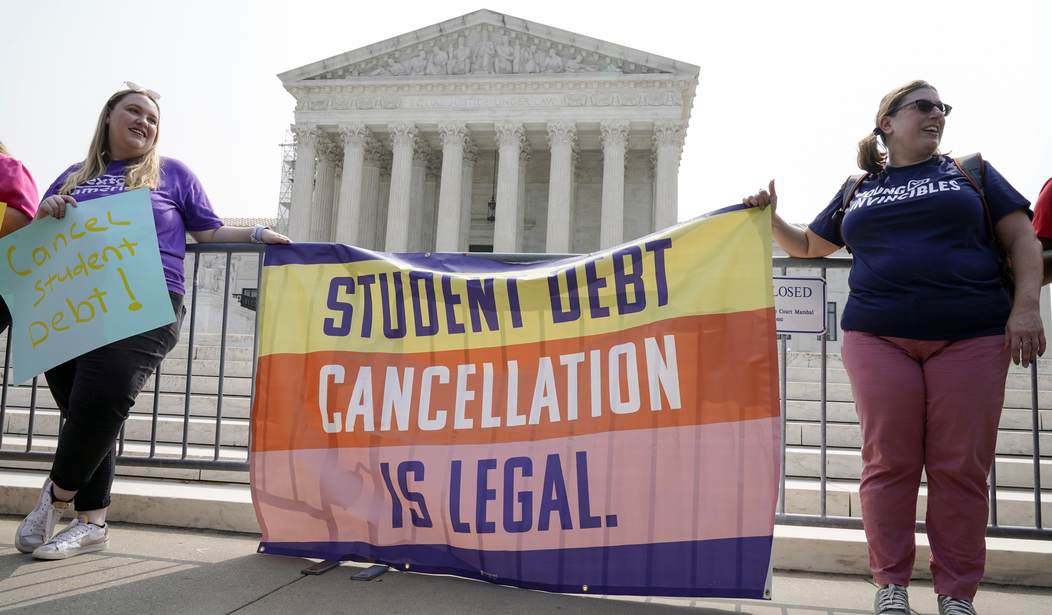Joe Biden’s latest scheme to make an end run around Congress and the law to pay off student loan debt is his latest vote-buying plan to attract the support of college graduates.
Biden has already announced a $39 billion dollar loan forgiveness plan based on existing income-driven repayment plans offered by the government. But that’s just a drop in the bucket. In the “Saving on a Valuable Education” (SAVE) Act, Biden will use the mechanism of “income-driven repayment” (IDR) plans to forgive a lot more than $39 billion.
“Under most IDR plans, borrowers pay a specific percentage of their income each month for a set number of years—usually 20 or 25 years—after which their remaining balance will be forgiven. Previously, payments were required to be on time and in full in order to count toward cancellation,” according to Reason’s Emma Camp.
Under the SAVE Act, many borrowers will be able to satisfy their requirements for forgiveness according to a much broader set of circumstances. These include partial or late payments, economic hardship, and periods like the pandemic when loan payments were deferred.
The result is more magic wand waving from Biden.
“We estimate SAVE will incur a net cost of $475 billion over the 10-year budget window,” the University of Pennsylvania’s Penn-Wharton Budget Model announced this week. “About $200 billion of that cost will come from payment reduction for the $1.64 trillion in loans already outstanding in 2023. We estimate that about 53 percent of the current loan volume will move to SAVE after it goes active in July 2024, implying that about $869 billion will be subject to enhanced subsidies under SAVE. The remainder of the budget cost, or about $275 billion, comes from reduced payments for about $1.03 trillion in new loans that we estimate will be extended over the next 10 years.”
Where the Penn-Wharton model of Biden’s initial loan forgiveness program that was smacked down by the Supreme Court cost in excess of a trillion dollars, Biden appears to be letting us off easy by socking it to the taxpayer for $475 billion.
The Congressional Budget Office (CBO) estimated in March that the “new income-driven repayment plan would increase the government’s costs for federal student loans originated through 2033 by $230 billion.” But that estimate also predated the publication of SAVE’s final regulations. The CBO has yet to update its estimate for the plan’s costs.
So what’s a few hundred billion dollars in debt between friends, right? The problem is that it’s all part of the bigger issue of the out-of-control-debt and a clock ticking somewhere offstage that’s getting closer to midnight. How much longer will the gods of finance allow us to float free of serious consequences?
“Our debt addiction of more than $5 billion per day will be hard to come down from, but it is vital that we do so for both current and future generations,” comments Maya MacGuineas, president of the Committee for a Responsible Federal Budget. “As of this month, we’ve now spent more on interest on the debt than we did for the entire previous fiscal year, and we are projected to spend more on interest payments in the next decade than we will on the entire defense budget. We’re on track to have interest be the single largest line item in the budget by 2051 — larger than our two current biggest programs, Social Security and Medicare.”
Think of what those interest payments could be funding or how much of a tax cut they could lead to.
The SAVE Act isn’t quite as cockamamie as Biden’s previous effort at forgiving student debt. At least you won’t have to turn yourself into a pretzel trying to legally justify the debt forgiveness. The bad news is that this will make it harder for a court challenge to the repayment plan to succeed.
But the plan still fails the “major questions” test of leaving Congress out of the decision on big issues. It will depend on whether SCOTUS sees $475 billion as a “major question” or not.










